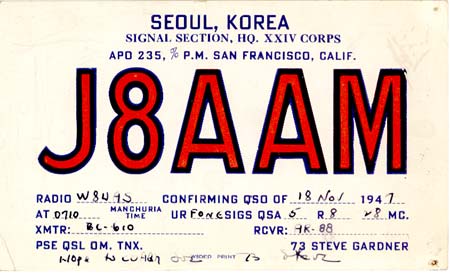
Ham activities during the period of 1945~1950 (in Korea)
by Sang M Lee, K7MOK(ex-HM1GB)
Korea's Yi dynasty has ended in 1910 and was annexed by Japanese Imperial government. After liberation from Japan at the end of World War II in 1945, Korea was divided into North and South Korea according to the US and Soviet agreement in 1945. During Japanese occupation Korea's call prefix was J8 as part of Japan.

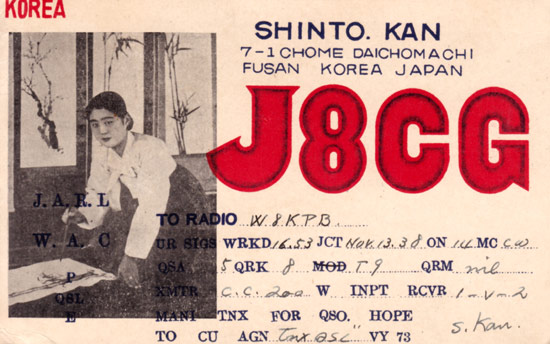
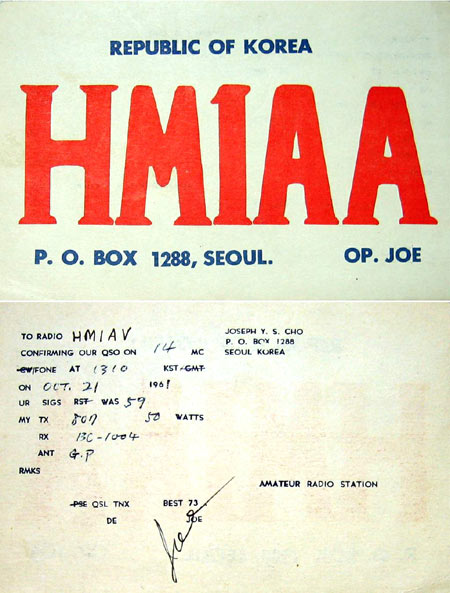
The US Army Military Government controlled South Korea for three years from 1945 until 1948. Korea became officially the Republic of Korea (South Korea) on August 15, 1948. Korean War broke out on June 25, 1950 and ended on July 27, 1953. KARL (Korean Amateur Radio League) was founded in 1955 but no official individual amateur radio license given yet until 1960. Only several school club stations (experimental stations) were licensed to operate ham radios. These stations are given HL2 prefix such as HL2AC, HL2AG, HL2AO and so on regardless of area. QSO's were limited only to domestic and local stations. First individual ham radio license to Korean citizens was issued with prefix HM starting with HM1AA (HM1AA, HM1AB, HM1AC. HM1BA, HM1BB, in this order) in 1960.
Until then ham radio licenses were only issued to US personnel (mostly military soldiers) with HL9xx calls. I myself got my license HM1GB in 1970 and it was 158th ham license that I'm so proud of. Prefix HM has been completely changed to HL and plus more call letters such as DS, 6K, etc in 1982 since prefix HM was turned over to North Korea. I came to America before 1982 so I still stick to ex-HM1GB. Last year the KARL has published a special issue of 60th anniversary and introduced three Korean amateurs (J8CK, J8CG, and J8CE) who had been operating during Japanese occupation from 1910 through 1945. Their rare QSL cards were also presented thanks to K8CX's hamgallery.com.
In this issue I'd like to present about ham activities during the US military government from 1945 to 1948 and how hams helped on the days of Korean War breakout based on March, 1951 issue of QST and Raymond Maurstad's (W3HUV, ex-HL1CE) autobiography "SOS Korea 1950". Since no Korean (citizen) amateur stations were awarded during this period (from 1945 to 1955), most amateur radio stations had been operated by US military personnel. I introduced briefly W3HUV story as HL1CE in Korea in December 2004 issue of KARL magazine. Ray was actively on 7 MHz CW net from his home in Minnesota. He became SK on October 10, 2012.
After liberation in 1945 Korea was still holding prefix J8 that leads to show it as part of Japan. Many old QSL cards on hamgallery.com shown here are J8 stations operated in 1947. Some eye-catching cards are W6YAW/AK and W2OAA-J8. They used their US call sign plus call area J8 or AK (Asia Korea). "J8" meant both call prefix and area as part of Japan during occupation era. W2OAA-J8 claims his station as "Korea's First Postwar station" so we might guess he might have been operated at least from 1945. On February 15, 1948, the prefix HL was officially assigned to Korea, so W2OAA-J8 started to send his call letter as W2OAA/HL.
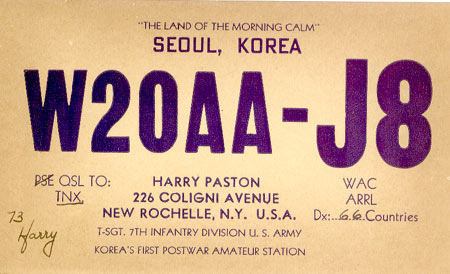

South Korea's national Korea Broadcasting System (KBS) has also changed its call sign from JODK to current HLKA. In 1948 the US military radio station WVTP opened in Seoul as part of Far East Network. There were two more stations WKLG (at Chunju) and WKLC (at Busan) in Korea. But both WKLG and WKLC closed their doors earlier in 1948. WVTP was handed over to US KMAG (Korea Military Advisory Group) on June 30, 1950 because of Korean War. During this time the US embassy was issuing evacuation instructions to American citizens via WVTP station to evacuate to Inchon then to Japan by sea. To US personnel the call signs from HL1AA thru HL1ZZ were issued regardless of area during this period. Later after the war the prefix HL9xx were exclusively assigned to American military and citizens.
When Korean War broke out in 1950 there was handful of amateur operators in Korea. Francisco, a technician working with WVTP station, had been operating HL1US in the US embassy in Seoul. Raymond Maurstad was another active amateur who was operating HL1CE. He was a radio officer on a commercial freight ship delivering goods between Korea and Japan and was living in Busan (Pusan) with his wife. One day he met George Terhune (W4AYE), a radio officer on the Pioneer Wave, showing his ham radio station on the ship that he could connect to his families in the States using phone-patch. Raymond was overwhelmed and bought his gears (NC-200 receiver and Meck T-60 transmitter, Millen VFO and Turner D150 microphone) for $200. He was soon awarded Korean license and call sign HL1CE. As the war breaks out at the dawn on Sunday, June 25 1950, no one was sure what's going on. Hams both in Korea and Japan has played a crucial role during the first urgent 48 hours of war break. QST magazine and Ray's book shows the discrepancy who called CQ first. It seems Ray HL1CE sent the CQ first. Here are initial QSOs between HL1CE and JA2DD (Donald Dickinson, 71st Signal Service Battalion) and JA2KK (Joseph Ziglinsky, 71st Battalion) quoted from his book. Ray's call sign was HL1CE, not as HL1CD as stated in QST 1951, but QSOs are pretty close on both books.
HL1CE: Mayday Mayday Mayday. This is amateur radio station HL1CE in South Korea wishing to establish a dedicated 10-m channel with Tokyo to report the invasion of South Korea by the republic of North Korean people's army. This is distress. Please stations in Japan only answer to HL1CE...over
JA2KK: This is JA2KK in Tokyo. The name is Joe, go ahead.
HL1CE: This is Ray in Pusan and are we ever glad to hear from somebody in Tokyo. We are worried stiff about things here...The North Koreans are attacking South Korea and are reported to be moving into Seoul... What are you hearing over there?
JA2KK: We have nothing yet Ray, I'll try to contact HL1US in Seoul...They are closer to the fighting. Can you please get on your landline phone Ray, and call Francesco and Al for me? Tell them I will be looking for them on the 20m band. It's more reliable. Do you have landline to Seoul?
HL1CE: Yes, I think so and will do Joe, but keep in touch with us too. We want to know what to do down here. Will stand by. We'll find you on 20m later and establish a dedicated channel there. This is HL1CE. Back later.
JA2KK: OK Ray, we will all meet on 20m until the thing clears up. This is JA2KK.
During Korean War George L Morrow (W8WFB), a former US Marine, are believed to have CW QSO on 20m band in North Korea with call sign HL1MC. But unfortunately I couldn't find any QSL cards or logbook available to back up the story. The KARL was founded in 1955. While Korean government has been issuing amateur radio licenses to Koreans, prefix HL9 was exclusively assigned to US military and citizens. HL9US was established in the US 8th Army in Seoul in 1964. William J Porter, US ambassador to Korea during 1967 to 1971, had operated HL9AA. He was the chief American delegate to the Vietnam peace talks in Paris in 1971 and 1972.
I give many thanks to Raymond Maurstad (SK) and Maty Weinberg, KB1EIB, production coordinator of ARRL for allowing me to use part of articles of QST magazine. I also thank Tom Roscoe (K8CX) for his generosity to allow me to use invaluable various QSL card images I needed. Thanks for Thom Wheston for using some photos from his blog, particularly of WVTP radio station in Seoul. He has worked as DJ for AFKN (American Forces Korea Network) during 1976~1977 in Osan Air Force Base, Korea where I have served my military duty in early 1970's. My thanks go also to KE6AJ for his old QSL collection (HL9AA, HL9US, HM1AA shown here).
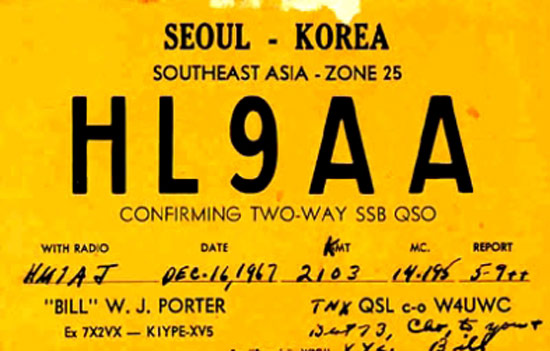
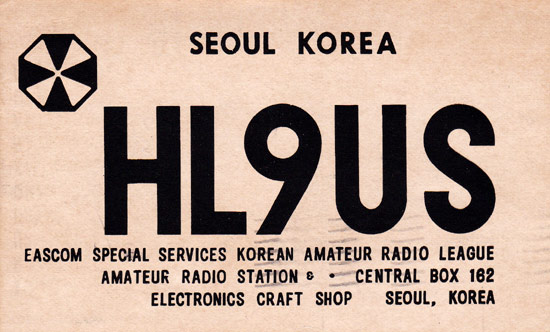
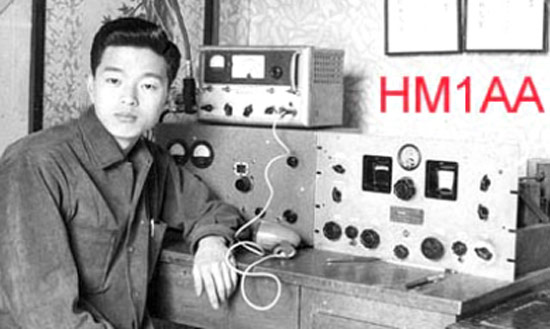
73, de K7MOK
Story, Info courtesy of Sang M Lee, K7MOK (ex-HM1GB)
This site is
copyright © by K8CX of Paradox Design Group (PDG).
All Rights Reserved. All art, photos, and html is property of
PDG.